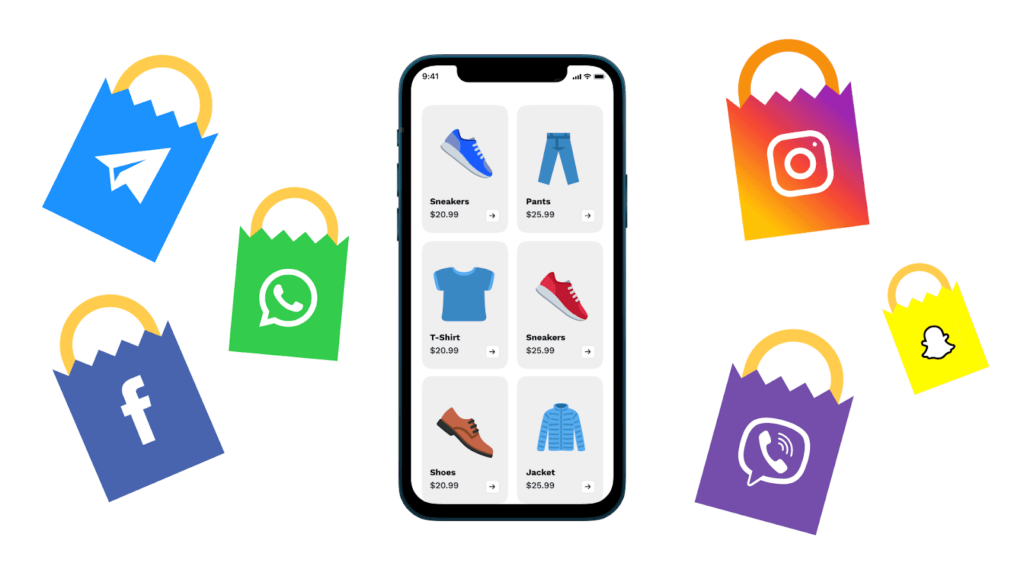Social Commerce: How It’s Changing the Way We Buy and Sell
Shopping has come a long way from traditional brick-and-mortar stores. The rapid growth of social commerce—shopping directly through social media platforms—has transformed how we buy and sell. With platforms like Instagram, Facebook, and TikTok integrating shopping features, businesses now have the chance to reach customers where they already spend much of their time. For businesses, understanding social commerce and its potential is key to engaging customers, enhancing brand visibility, and driving sales. This article explores the rise of social commerce and how businesses can harness this trend to boost growth.

What is Social Commerce?
Social commerce is the practice of selling products directly through social media platforms, allowing customers to browse, shop, and make purchases without leaving the app. Unlike traditional e-commerce, which takes users from a social platform to a website, social commerce keeps everything within the social media environment. This seamless shopping experience offers customers a more convenient way to shop and lets businesses tap into a growing trend that combines engagement and shopping.
The shift towards social commerce reflects the growing influence of social media in daily life. For businesses, it means meeting customers in a familiar space, where they are more likely to engage with products, seek recommendations, and make purchases.
Why is Social Commerce on the Rise?
Several factors are driving the growth of social commerce. These include:
- Increased Social Media Use: People are spending more time on social media than ever before. As users scroll, discover, and connect, shopping has naturally integrated itself into the experience.
- Seamless Shopping Experiences: Social commerce reduces the steps in the buying journey, allowing users to see a product, learn about it, and buy it without navigating away.
- Influence of Visual Content: Platforms like Instagram and Pinterest, which focus on visual content, make it easy for businesses to showcase products in an engaging and appealing way.
- Influencers and User-Generated Content: Social commerce is boosted by influencers and real customers who create and share content, providing authenticity and building trust among followers.
These factors create an environment where shopping feels natural, fun, and less formal, making it a preferred method for many users.
Key Social Media Platforms Driving Social Commerce
Several platforms have introduced unique shopping features that make social commerce possible. Here’s how some of the leading platforms contribute to this trend:
1. Instagram Shopping
Instagram has evolved from a photo-sharing app into a powerful social commerce platform. With Instagram Shopping, businesses can create a storefront, tag products in posts, and add product stickers to Stories. Customers can tap these tags or stickers to learn more about the product, visit the shop, and purchase without leaving Instagram.
2. Facebook Shops
Facebook offers a Shops feature that lets businesses create a customised online store. This feature allows businesses to upload product catalogues, customise their shop’s appearance, and reach customers through Facebook’s extensive user base. With integrated checkout options, users can complete purchases within Facebook.
3. TikTok Shopping
TikTok has become a significant player in social commerce with its TikTok Shopping feature. Businesses can showcase products directly on their profiles and link these products to checkout pages. TikTok’s algorithm also makes it easy to reach potential customers through viral trends and challenges, making it a valuable platform for driving sales.
4. Pinterest Shopping
Pinterest is known for its visual inspiration, making it ideal for showcasing products. The Pinterest Shop feature allows businesses to tag products and link them directly to online stores. This feature capitalises on Pinterest’s popularity as a platform for discovery and ideas, attracting customers who are actively looking for products.
Benefits of Social Commerce for Businesses
Social commerce offers a range of benefits that make it an attractive strategy for businesses aiming to grow their online sales and build brand awareness:
1. Increased Reach and Visibility
By selling on social media platforms, businesses can reach a larger audience, including users who may not visit their website. Social media’s sharing and discovery features can also introduce products to new customers.
2. Enhanced Customer Engagement
Social commerce creates opportunities for interactive engagement. Customers can comment, ask questions, and receive immediate responses, building trust and strengthening the customer-brand relationship.
3. Improved Conversion Rates
With fewer steps in the buying process, social commerce reduces friction and increases conversion rates. Customers can buy directly from the app, simplifying the experience and leading to faster sales.
4. Data Insights
Social media platforms provide valuable data on customer behaviour, preferences, and purchasing patterns. These insights help businesses refine their strategies and tailor their marketing efforts to target the right audience.
How Businesses Can Capitalise on Social Commerce
To make the most of social commerce, businesses need a strategic approach that maximises reach and builds credibility. Here are key steps to succeed in social commerce:
1. Optimise Your Social Media Profiles
Ensure that all social media profiles are fully optimised for social commerce. Add clear descriptions, use professional branding, and provide easy-to-access shopping options.
2. Leverage High-Quality Visual Content
Since social commerce is visually driven, high-quality images and videos are essential. Use bright, clear images, video demos, and engaging visuals to make products more appealing. Short video clips showing products in use can also drive higher engagement.
3. Collaborate with Influencers
Influencers play a significant role in social commerce by reaching niche audiences and creating authentic product recommendations. Partnering with influencers who align with the brand can help build credibility and reach a larger audience.
4. Engage Customers through User-Generated Content
Encourage customers to share their experiences with your products on social media. Reposting user-generated content shows potential buyers that real customers love your products, enhancing trust and credibility.
5. Use Social Proof to Build Trust
Social proof, such as reviews, testimonials, and star ratings, can boost confidence in potential buyers. Featuring this content in posts and stories helps build trust, making customers more likely to buy.
6. Run Exclusive Social Media Promotions
Offering special promotions, discounts, or limited-time deals exclusively on social media can incentivise followers to purchase. Promotions can create a sense of urgency, leading to quicker conversions.
The Future of Social Commerce
Social commerce is rapidly evolving, with platforms continually introducing new features to make shopping easier and more enjoyable. As technologies such as augmented reality (AR) and artificial intelligence (AI) become more integrated, social commerce will likely become more immersive, allowing customers to try products virtually or receive personalised recommendations.
For businesses, staying updated with the latest trends in social commerce is essential. Embracing new features, refining social strategies, and investing in engaging content can ensure that they continue to benefit from this growing trend.
Conclusion
Social commerce is reshaping the way we buy and sell, offering businesses a unique opportunity to engage customers and drive sales directly through social media platforms. By making the shopping experience seamless, visually engaging, and interactive, social commerce helps brands reach wider audiences, build trust, and convert social media engagement into actual sales. For businesses ready to embrace this trend, optimising profiles, collaborating with influencers, and engaging with customers can make social commerce a powerful tool in their marketing arsenal. The future of shopping is social, and businesses that tap into social commerce now will be well-positioned for ongoing success.
FAQs
1. What’s the difference between social commerce and e-commerce?
Social commerce enables purchases directly on social media platforms, while e-commerce typically takes place on dedicated online stores.
2. Is social commerce suitable for small businesses?
Yes, social commerce is an excellent opportunity for small businesses to reach new audiences without needing a full e-commerce website.
3. How can I encourage customers to buy through social media?
Use engaging visuals, offer exclusive promotions, and showcase user-generated content to build credibility and encourage purchases.
4. Do I need to use every social media platform for social commerce?
Not necessarily. Focus on platforms where your target audience is most active and where shopping features align with your brand.
5. What role do influencers play in social commerce?
Influencers help build trust and reach niche audiences, making social commerce campaigns more authentic and effective.





